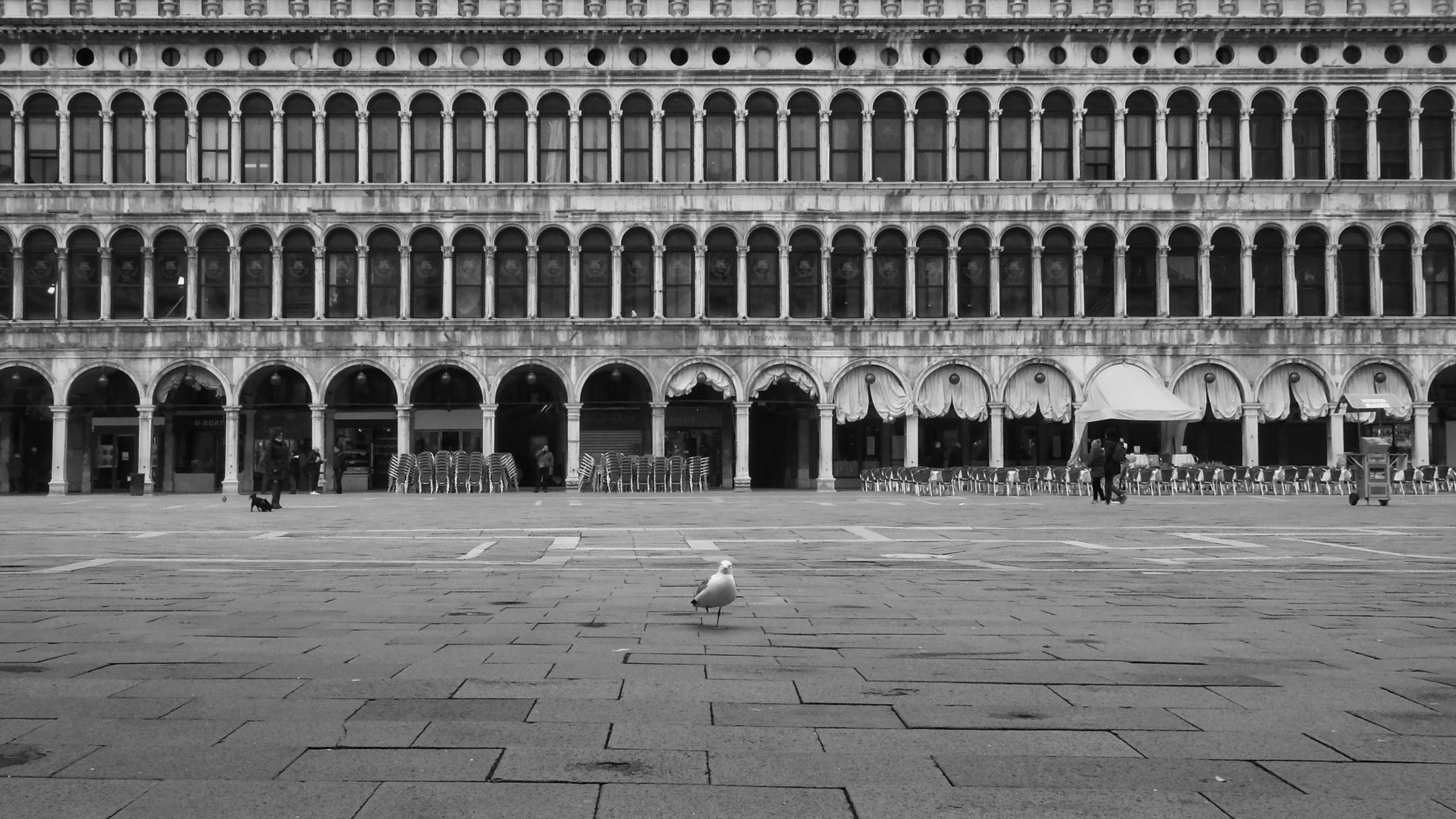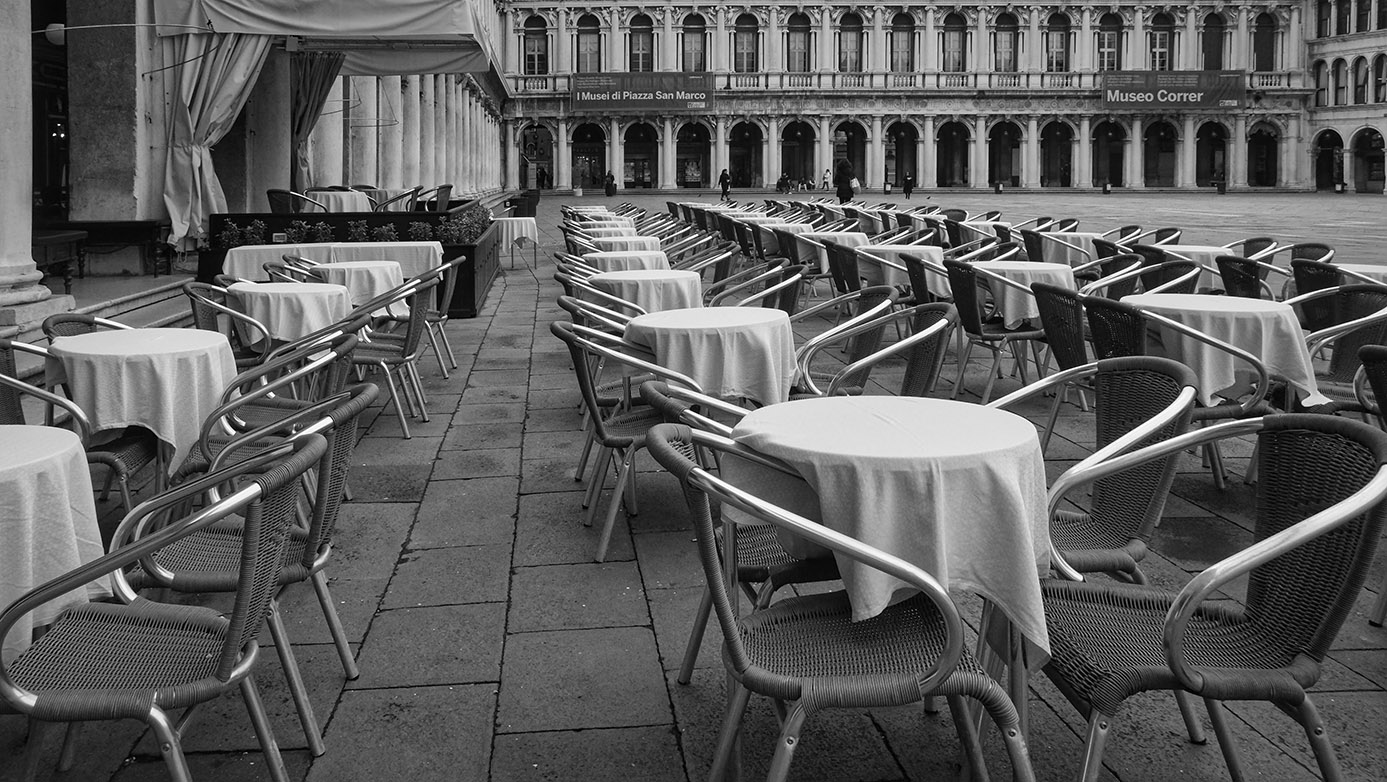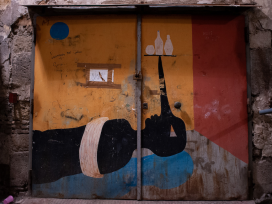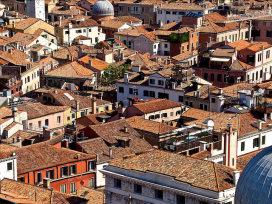
Photo by Sergi Brylev on Unsplash
Dolphins in central Venetian canals, a peacock on the streets of Lodi, Lombardy, ducks in a Florence chemist – Italian cities had some surprising visitors during lockdown. Sightings of animals such as these gradually advancing into spaces left empty by suspended human activity were one of the lockdown’s most popular literary topoi. And it was not until Italy’s restrictions were loosened in May, when the boats and gondolas for tourists took to the canals again, that the dolphins moved back to their more usual habitat. Everything had seemingly returned back to normal. But urban routines and balances were not entirely restored. The country’s most historic cities remained near deserted, largely devoid of their most populous and profitable human fauna: international tourists.
In Florence, the pandemic-induced drop in international visitors has left retailers without customers and significantly reduced municipal coffers. In 2020, almost 50 million euros were projected to flow into the city from its tourist tax alone. Forced to revise this economic forecast downwards, the mayor Dario Nardella threatened to cut off street lighting in an effort to balance the books. But local restrictions are not the sole answer. And local citizens can not single-handedly revive an economy based on massified touch-and-go tourism. Indeed, many exasperated by excessive urban gentrification and touristification have already left urban centres. Omnipervasive short-term letting and urban depopulation are embroiled in a vicious circle.
At the peak of its demographic expansion in 1951, Venice’s historic centre counted 175,000 inhabitants. Seventy years later, this figure has nearly dropped to 50,000. As neighbourhood facilities were converted into souvenirs shops, the city gradually became a ‘Disneyland on the sea’, inducing more and more Venetians to relocate to the city’s productive outskirts. Once a thriving maritime republic, Venice is now facing two diametrically opposed yet equally tragic destinies: being submerged underwater or deserted by its own inhabitants. The debate on the unsustainability of giant cruise ships stearing dangerously close to St. Mark’s Square also cyclically resurfaces, but the local community struggles to pressure the tourism industry and its economic interests.
Currently, the lagoon city’s depopulation appears to have reached its saturation point, as remaining inhabitants are those most attached to the city. However, its low birth rate is still disproportionate to a predominantly elderly population. The ‘counter of Venetians’, installed in a downtown chemist in 2008 by a local association eager to raise awareness of the issue, highlighted but could not reverse the trend. The decline proceeded undaunted, only a little less discreetly.
‘Venexodus’, as Venice’s depopulation has been baptized, finds several similarities in many other Italian touristic hotspots. In Rome, while the overall population is increasing, citizens are moving out of the historic centre, which lost almost 20 thousand inhabitants between 2001 and 2016. In Florence, the move towards a logistically more liveable periphery started in the 90s. Universities and their students have slowly moved towards less central parts of the city that are not already exclusively consecrated to tourism. Residents in the historic centre, which in the early 2000s were around 100,000, fell to below 20,000 in 2018.

Photo by Sergi Brylev on Unsplash
The tourism ‘revolution’
Within this context of long-standing demographic decline, Californian friends Brian Chesky, Joe Gebbia and Nathan Blecharczyk commercialized an idea that seemed to have the potential to revolutionize mass tourism and decongest city centres. In 2008, the three founders of Airbnb provided the first platform for homeowners to rent out their spare rooms or flats. The short-term letting principle promised to capillarize tourism by recognizing and upgrading areas lacking big hotels. Through its peer-to-peer foundational approach, Airbnb also promoted more personalized tourism. ‘Travel like a human’ was the slogan embodying the spirit of the then startup company. Airbnb rode the wave of enthusiasm for the so-called ‘sharing economy’, the cultural manifesto of a generation who had experienced the financial crisis and were compensating for its consequences with smart economic solutions with a note of sustainability on top.
At a company’s convention in 2016, the Italian Minister of Cultural Heritage and Tourism Dario Franceschini praised Airbnb as a ‘multiplier of cultural sites’. One year later, Airbnb and the ministry had launched a cooperation aimed at rediscovering and promoting about 40 Italian towns. However, as it became massified, Airbnb and other similar platforms that followed its path had already disregarded their original promise. By 2019 Italy had over 450,000 rentals listed on Airbnb, the large majority located in the already hyper-touristified city centres it originally intended to decongest. After Porto, Lisbon and Copenhagen, Venice and Florence were the fourth and fifth most highly serviced European cities in terms of Airbnb listings with 301 and 295 properties per ten thousand inhabitants, respectively. Milan, meanwhile, had 129, Rome 102, Bologna 100 and Naples 74.
The vast amount of short-term offers – in Rome alone, there are almost 30,000 listings – may favour downward competition, but it simultaneously reduces the amount of long-term rentals and artificially inflates costs. In the second half of 2019, the rental of two-room apartments increased by 8.5% in Milan, with the average price hitting a 1,300 euro high. As prices go up and residents leave city centres, the revolutionary peer-to-peer spirit of services such as Couchsurfing becomes a distant memory. The depersonalization of mass tourism previously blamed on large hotel chains, where interactions are limited to checking in and out routines, is now accentuated by platformized tourism. Apartments often have safety deposit boxes for key collection and return; human interaction has been reduced to zero.
Moreover, what was initially conceived as a way for homeowners to sublet their apartments a few weeks a year is being used by many as a stable source of income instead. Those who move to the suburbs turn their city-centre properties into year-round tourist accommodation, encouraged by the potential income. Data from InsideAirbnb, which has been documenting the impact of digital platform tourism on cities around the world since 2014, shows that most landlords rent out their property to tourists throughout the year. In Bologna, 80% of listed accommodation is available for short rentals for over 60 days a year. In Naples, the percentage rises to 93%.
Revenue opportunities have also attracted businesses and investment funds to the short-term letting orbit. Multilisting hosts are common on rental platforms, making up over 50% of estimated revenues. Many professional services manage properties on behalf of owners. In Italy, ‘Halldis Apartments and Villas’ – until recently known as ‘Bettina’ in alignment with the re-humanizing narrative – defines itself as ‘a group of professionals serving the vacation rental market’. Although the company’s rentals have been decreasing in the aftermath of the pandemic, it still has over 600 Airbnb listings. ‘Apartments Florence’ manages about 400 properties in the city and its surroundings with almost 200 listings on the platform. Not quite the typical local hosts renting out their spare rooms on the side.
The discrepancy between the expectations and reality of platformized tourism is partly a problem of definition. In terms of its massified effect, the economy of rental platforms has very little to do with collaborative forms of exchange. The service introduced an efficient form of intermediation but not an alternative to existing economic structures. Decentralized peer-to-peer transactions are only possible through highly centralized systems, which coordinate digital and social interaction and retain a percentage on every booking. In its most turbulent year, in which 1,900 employees – a quarter of its total workforce – have been laid off, Airbnb is now ready to go public, following the path of other ‘unicorns’ (startup companies that have reached a value of over one billion dollars). Before the pandemic, Airbnb had been valued by private investors at US$31 billion.

Photo by tomaskju from Pxhere / CC0 Public Domain
Daily repercussions
Workers’ rights are an evasive aspect of such revolutionary economics. Unrecognized professions have flourished around the new business sector and forms of exploitation or self-exploitation are not uncommon. In the case of Airbnb, people in charge of checking guests in and out often end up being on call round the clock without any overtime or sick leave reimbursement.
Other digital startups face similar issues. A court ruling in California required Uber and Lyft to recognize their drivers as regular employees rather than independent contractors. But the ruling, initially intended to come into force on 20 August, has been suspended by an appeals court after the two companies threatened to leave the state. Therefore, at least for a few more months, it will be business as usual. Behind the rhetoric of its startup origin and captivating language formulas, the so-called sharing economy has often brought with it forms of deregulation. Neoliberal anarchy is being concealed under the cloak of innovation and flexibility.
And the social impact of platform capitalism is not limited to issues related to workers’ rights. As far as tourism is concerned, the Airbnb model brings radical changes to the urban ecosystem, of which city centre depopulation is only one aspect. Touristic hypermobility places a market value on the city itself; such totalizing and all-pervasive commodification spares no level of urban life, from food and wine to culture and crafts. Tourists are the gravitational center of martketing strategies apparently aimed at immersing them in the most authentic local tradition but which actually overturn the hierarchy: ultimately, the local ecosystem undergoes heavy transformations to match touristic demand. In Florence, thousands of activities linked to local traditions have closed down in the last three decades. Platformized tourism promises authenticity while contributing to its annihilation.
Touristification is also among the reasons for the securitization of cities, whose attraction is perceived as directly proportional to urban décor. Florence holds the record among Italian cities for the number of surveillance cameras by population: there’s now one device for every 380 inhabitants, the thousandth having been proudly inaugurated last December. In Como, which also features among Italy’s favourite destinations for international tourists, the experimental use of cameras equipped with facial recognition technology was trialled last year in a park next to the main railway station, which in 2016 had turned into a bivouac of immigrants. The Italian Data Protection Authority has since suspended the facial recognition functions, but the right-wing city administration continues to be particularly hostile to those who alter its glamorous image. Migratory movements represent the perceived deleterious counterpart to touristic hypermobility.
And Como had already hit the headlines in Christmas 2017 when mayor Mario Landriscina enacted an order against homeless people begging around the historic centre. Just like immigrants, the homeless are perceived as a discordant note, a threat to the exchange value of commodified urban spaces. They suffer double discrimination from an exclusionary system that first turns the right to housing into a privilege of the rich and then rises up against those who cannot afford it. During the lockdown, people living on the streets were exposed to high risks of contagion, unable as they were to comply with safety regulations. And some were fined by the police: there was no exception to the ‘stay at home’ imperative even for those who did not have one.
The most recent study conducted by the Italian National Institute of Statistics (ISTAT) dates back to 2014 and estimated that 50,000 homeless people lived throughout the country with Milan, Rome and Palermo accounting for the biggest share. But people living on the streets often remain a silent element that goes unnoticed until they represent a perceived danger towards urban decorum or public health. The economic crisis following the coronavirus pandemic could further aggravate homelessness; during the emergency, families who accumulated rent arrears reached 24%, compared with 9.6% before the pandemic.
The housing gap
While the COVID-19 pandemic may have acted as an amplifier of social inequalities, the housing crisis was already ongoing, exacerbated by platformized mass tourism. On the one hand, online accommodation platforms have been agents of social levelling, competing with hotels to make tourism and travel less exclusive. But, on the other hand, Airbnb and the like have contributed to making a gentrified, exclusive and unequal urban environment that benefit the platforms themselves, low-cost travel companies and real estate investors.
The pandemic has jammed many sectors, including tourism, especially the international industry. As a result of the current slump in demand, some landlords may be willing to turn away from short-term lets to increase the volume of available long-term rentals. In Portugal, Lisbon’s mayor Fernando Medina has decided to nudge landlords by launching ‘Renda Segura’, a ‘secure income’ project. Property owners can rent out their houses to the municipality for a minimum of five years. Then the municipality itself makes those properties available for long-term tenants at an affordable price, bringing students and key workers back to the city centre.
A similar proposal has also been floated in Italy, but, for now, it remains only an idea. In Milan, which alongside Lisbon is part of the C40 network, a group of cities are ‘leading the way towards a healthier and more sustainable future’, mayor Beppe Sala has always declared himself aware of the housing crisis, yet categorically opposed to operations that could disrupt the free market. The pandemic alone does not seem to have turned the tables when it comes to real estate prices, which fell only slightly in the aftermath of the lockdown. House selling prices in Italy decreased by 0.4% and rental costs by 1.6% in the first half of 2020 compared with the same period of the previous year. As a consequence of the months spent at home during lockdown, the demand for rented properties that have exclusive outdoor space has even increased.

Photo by Alev Takil on Unsplash
New destinations?
Meanwhile, as tourism slowly resumed post-lockdown, Airbnb adapted some of its marketing cornerstones to fit the pandemic scenario. CEO Brian Chesky was already considering the inevitable transformations that tourism would undergo in May: ‘People will want options that are closer to home, safer, and more affordable. But people will also yearn for something that feels like it’s been taken away from them – human connection’, he wrote. In June, Airbnb launched the ‘Go Near’ campaign, insisting on safer and more sustainable domestic travel.
In the wake of this new trend, Italian inland areas are attracting more visitors when compared with previous years. The performance of the Tuscan hinterland is impressive: at the beginning of August, Airbnb hosts recorded +140% in revenues compared with 2019. In the province of Florence, the exponential growth of tourists is a counterbalance to the semi-deserted city. A growth in tourism could certainly help smaller areas recover quicker from the crisis. However, proximity tourism is a reiteration of the re-humanizing narrative that accompanied platformized tourism’s rise. It would be prudent to remember how the online sector proposed itself as a sustainable alternative to an unequal and predatory system before becoming one of its main vehicles.
As for large cities economically affected by the pandemic, they are concerned with making ends meet. In July, Rome became the twenty-fourth Italian city to sign an agreement with Airbnb for the platform to collect the tourist tax on behalf of the municipality: 3.50 euros per night per person, the most expensive in Italy. The agreement is also a way to recover undeclared revenues in the short-term rental sector, where regulation is not always effective and transparent.
However, in the absence of an alternative model of urban development that is inclusive and sustainable, such agreements can only improve the efficiency of the status quo without questioning it. Unlike several cities around the world, from Amsterdam to Barcelona, Paris and New York, Italian cities have so far lacked the political will to challenge a system that commodifies and consumes urban centres to the benefit of those platforms that have made tourism ‘smart’ – at least for themselves.











